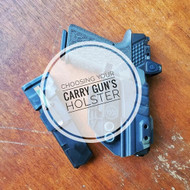An Intro to Concealed Carry - Part 3
Posted by TacCat on Sep 1st 2020
Picking Your Carry Gun's Holster
Hey all you cool cats and kittens! Recently I was asked to do a guest article for LOX… I started writing it and finally asked, “Hey, this is going to be long. Want to turn it into a mini series?” And I got the green light! So, to get started, let me introduce myself.
My names Michael and I’m a hobbyist when it comes to firearms. I got into them around the end of 2015 and bought my very first handgun, a CZ 75B, in 2016. After that purchase I realized how much more there was to know about defensive firearms, carrying a firearm for defensive purposes, and more. That’s when I decided to start TacCat; a personal blog where I logged my own experiences with firearms as a novice, and worked my way up.
Basically, a way for me, and in turn you, to learn from my own embarrassment. So far though I’ve only taken a couple of impromptu courses, but now that I’ve settled on the platform that will be changing once I get all of the modifications I’ve deemed necessary done.
There’s a lot of arguments that get had online about a person’s concealed carry load out, such as, which part is the most important part? Is it the belt? The gun? The holster? Truth be told, each variable in this equation is equally important. You can have a fantastic firearm, but if the holster follows it out of the pants it’s useless. You can have a fantastic holster, an okay grade firearm, and a lousy belt… but the belt doesn’t hold up the gun and it doesn’t retain the holster which results in the gun/holster plopping onto the ground.
For the sake of brevity, this article will only contain information about In The Waistband (IWB) holsters and not Out of The Waistband (OWB) holsters. If you all are wanting an OWB guide, be sure to shoot LOX a message on Facebook, Instagram, or via email!
Unfortunately holsters aren’t the easiest thing to navigate when it comes to finding a good one, but I do have a small checklist for you to run over when you’re looking at them online.
1. Does it cover the entire trigger guard?
Yes? Good.
No? Move on.
2. Can it close in on itself?
Yes? Move on.
No? Good.
3. Is there an excessive amount of extra material?
Yes? Move on.
No? Good.
Exception to the rule: If you’re on a budget and there’s excess, but the edges are smooth, buy at your own discretion.
4. Do they use a proprietary attachment/clip?
Yes? Move on.
No? Good.
As far as attachments go for holsters, you have good ones, you have bad ones, and you have in between ones.
Starting off, the most common clip you’re going to see is what’s referred to as a FOMI clip. A LOT of holster companies run these as their standard clip due to how cheap they are. It’s been my experience though that they are less than effective. I’ve had them come off of my belt (even when tightened to the max) when just walking, I’ve had them come off my belt when getting up from a seated position, and I’ve had them fail when drawing the gun (meaning the holster was on the gun when presenting it).


Even though I’m not a fan of this attachment point, there is a very cheap upgrade you can do called the Discreet Carry Concepts Monoblock Clip. It will attach via the same holes so no fitting isn’t necessary and it’s infinitely more secure than the FOMI clip. Benefits of the Monoblock are that it’s more secure, as well as being a thinner, more discreet (haha) attachment than the FOMI clip.
If you’re a holster company that uses the FOMI as the standard attachment option, do some price checking, and see if you can run the Monoblock as your standard clip. Your customers will appreciate it greatly.


The next common attachment point, and rightfully so, are Pul-The-Dot loops, also known as soft loops. These are just belt loops that, well, loop around your belt and snap securely. These are arguably the most secure IWB attachment option on the market. I’ve personally had great experiences with soft loops, but there are a couple of downsides starting off.


Initially it’ll take a while to get use to snapping the clasps shut and if you don’t pull down on them properly they aren’t going to open up. They’re also not as convenient for taking off/putting back on when you’re not standing up (such as taking the holster out to walk into the Post Office or local court house depending on your locality).
The last common one we’ll go over is the J/C-Clip. These clips come in a variety of sizes, but the basic premise for them all is the same. The clip goes over the belt and has a lip on the backside that “latches” onto the back-side of the belt to secure it. These clips are a lot more secure, in my experience, than the FOMI clip, but they do have a downside. Being plastic (typically) they stretch out over time (the thinner ones stretching sooner) so you should replace them about once a year. — You’ll see these pictured on the sidecar holster down below.
Moving on from attachments, let’s go ahead and break down what’s arguably the most dangerous, and most useless holster on the market. This should help you with recognizing what to look for when determining whether or not a holster is worth your time and money. After all, you worked hard for your money, so why waste it?


This is a Versa Carry Orion, it’s one of their IWB holsters that’s meant to act as an OWB as well, and oddly their products get fantastic reviews (which really speaks to the intelligence of your average carrier).
What makes this product dangerous?
To start, there’s nothing rigid protecting the trigger/trigger guard which means debris can get inside the holster and potentially cause a discharge. This is arguably a bigger issue for OWB carriers, but it doesn’t end there.
When drawn from, this holster will close in on itself, forcing the user to use dangerous holstering techniques such as angling the muzzle at themselves to get the holster to open back up.
As this holster gets older and worn by the elements, it will grow softer, and there’s a high potential that you’ll end up having something like this happen to you. So don’t be that guy.
Side Note: The above story can happen with any leather holster, the propensity for it to happen though increases when the holster isn’t molded, and is already floppy to start with.
It also doesn’t have any retention (I’d triple dog dare any Versa Carry Orion or similar owners to do the upside down shake test). And with this open ended design, when you sit down the gun can press against the surface of the seat you’re on, and push itself partially out.
I’m not going to jump on a soapbox and tell you all leather holsters are bad, because they aren’t. I’m also not going to tell you all hybrid holsters are bad, because they aren’t. What I’m saying is watch out for stuff like with the holster above.
Is there rigid material around the trigger/trigger guard? Will it close in on itself? Is there even friction retention, or is it just held in by gravity?


For appendix carry, I’m sure many of you have seen what’s called a sidecar holster like what you see pictured. Unfortunately they all aren’t created equally.
Ones like the T.Rexx Arms Sidecar holster have the propensity to crack down the center (between the holster and mag caddy). A friend of mine actually experienced this with one of his. Phlster/Philly EDC actually did a very informative video explaining why the fractures happen.
Sidecar holsters like the Tier 1 Concealed Axis Slim and Legacy Firearms Hyperion solved the issue of fracturing my putting a flexible area between the caddy and holster. In turn you’re able to separate the two if you decide you don’t like how sidecar holsters feel.
My personal experience with sidecars is that they’re awesome for subcompact and micro guns. It helps keep them in place and prevents them from canting with your movement which can affect your draw. With compact sizes and larger, I’ve began to prefer running stand alone holsters. Having the mag caddy and the holster with a larger gun really just became to cumbersome for me; but they might work well for you!
Beyond sidecars for appendix carry, there’s attachments that can aid in keeping the firearm concealed (and these can help with strong hand carry as well). The first one is called a “claw”, seen on the left-hand side of the sidecar above. The claw is meant to press against the belt to push the gun in close against the body. This decreases how much the firearm is going to print and it’s going to keep it where you adjusted the holster to better.
The next is called a wedge. Wedges come in all shapes and sizes with a majority of them being made out of neoprene or similar material. Typically speaking, they’re attached to the backside of the holster to aid in comfort, as well as to push the grip closer in to the body. Having used a couple different styles of wedges now, I do have to say that the wider neoprene ones do give the most comfort… but you usually have to change them out about once a year. And before buying into a wedge, you can try out the “Lazy Man’s Wedge” that I did. It doesn’t cost a lot and they don’t seem to wear out like the neoprene wedges do.


The truth is, when it comes down to holsters there’s a good portion of it that’s user dependent, and there’s a good portion of it that’s quality/materials dependent. Honestly… it’s about a 50/50 split between the two. A lot of people hate sidecars, a lot of people love them. A lot of people love appendix carry, a lot of people hate it.
As a general rule of thumb, go over the questions I asked in this article when looking at a holster, and answer them truthfully. And, obviously be wary of their display photos on their websites. I’ve seen a lot of times where a holster will look great on their website, but then when you go to see the photos they’re tagged in (especially on Instagram) that there’s rough edges galore, and there’s 2x the amount of excess material than what they have for display.
My last bit of advice, avoid nylon holsters. None of them are good… at all for many of the same reasons the VersaCarry above isn’t good.
While you’re searching between holster websites trying, be sure to hit-up Lox to get some goodies, and use the code Cat10 for 10% off your order!
Thanks to TacCat for writing this very informative article in this series on Responsible Concealed Carry!
Stay Sharp. Stay Savage.®

